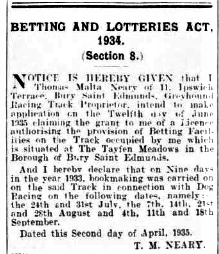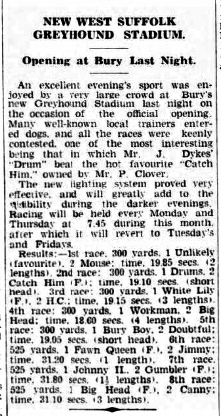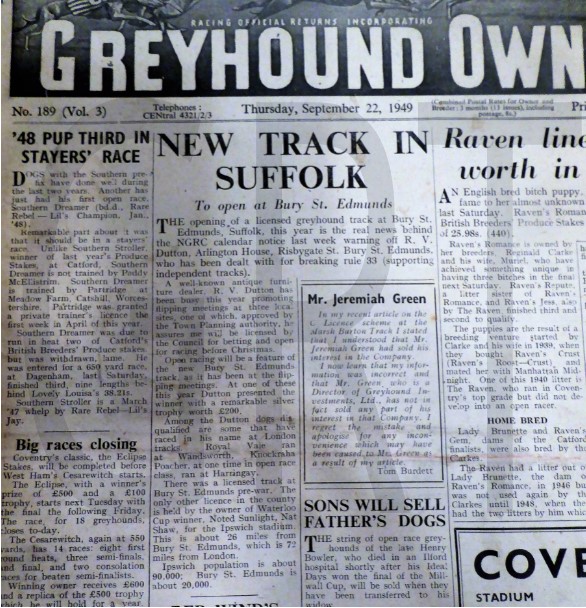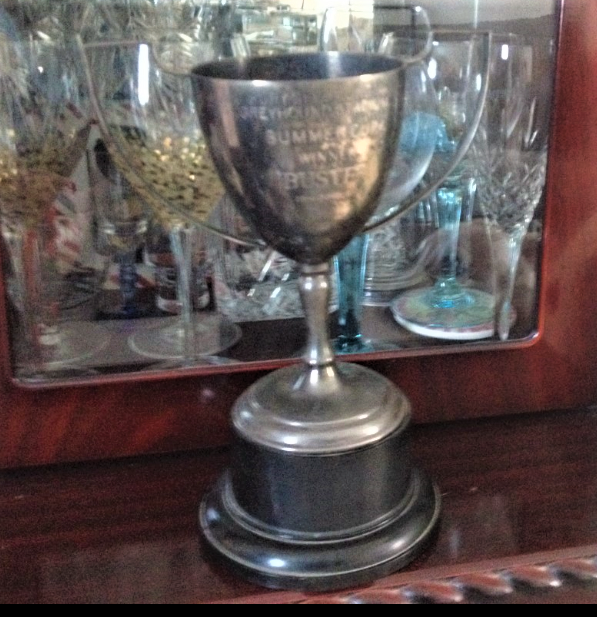Spring Lane, Bury St Edmunds, Suffolk.
POSTCODE———————————-IP33 3ZF
LOCATED————————————About one mile north west of town centre.
ORIGINAL SITE—————————–Built on grazing land known as Tayfen Meadows.
DATE CONSTRUCTED——————–Developed throughout the 1930’s.
DATE VENUE OPENED——————-1939
Meaning other sports may have taken place prior to the arrival of Greyhound Racing.
FIRST MEETING—————————–Racing on The Tayfen Meadows site from around 1932. Redeveloped and opened as West Suffolk Stadium on June 1st 1939. After a period of closure, it was upgraded and re-opened again on December 1st 1949.
Greyhound Racing only.
LICENSED OR INDEPENDENT———-Independent
All venues covered would have to be licensed with the government, licensed suggested in this section would refer to tracks operating under NGRC Rules.
INSIDE OR OUTSIDE HARE TYPE——Inside Sumner.
Please note that the Electric Hare suggested is only a guidance and would have been in operation for a certain amount of time at this venue. Although it is not necessarily guaranteed that it was operational all the time, as other types of lure may have been used and updated as time progressed.
DISTANCES———————————–277, 471, 655 and 877 metres.
Please note that most racing venues distances had become varied throughout the years, the ones given above were at once point set and offers only a guidance to the track size.
CIRCUMFERENCE—————————Don’t know
Please note that alterations at most racing venues throughout its existence would see that the circumference of the track would vary, the one shown above offers only a guidance to the track size.
BIG RACE NAMES—————————Magna Carta Stakes.
STADIUM SHARED WITH——————Nothing known of.
LAST MEETING——————————-June 25th 1996.
Greyhound Racing only.
STADIUM CLOSURE DATE—————-1996
Meaning other sports may have taken place after Greyhound Racing had ceased.
STADIUM DEMOLITION——————-1998
BUILT ON SITE——————————-Housing found on Fen Way and Marsh Way.
In some cases, structure’s that originally covered the venue after the stadium had been demolished, may have been themselves demolished too, so the one described is more likely to be the one which now presently covers the site.
EVIDENCE LEFT TODAY——————-Nothing known of.
FURTHER COMMENTS——————–None


















In my opinion, the county of Suffolk did not experience the boom of greyhound racing as in some other parts of the UK had done. The 1930’s had witnessed a limited serge, but only odd ones became established. No doubt Ipswich’s Suffolk Stadium could boast it had been the most successful, but try telling that to the flapping fraternity, who would no doubt say that the Bury St Edmunds West Suffolk venue would take some beating.
During the early 1930’s, Bury St Edmunds had already witnessed Greyhound Racing at a handful of temporary venues around the town, such as at Hardwick and St Andrews Road. Yet another venue began to flourish around this period and became known as Tayfen Meadows.
This track had developed on farm grazing land, situated about one mile northwest of Bury town centre, just off Spring Lane. The land originally had been drained marsh land which explained why it was prone to flooding throughout the winter months. Newspaper reports suggested gatherings had first taken place during 1933, but no doubt during this period it would have been primitive indeed, but probably more advanced than the other local temporary Greyhound Racing gatherings that had taken place.
Throughout the 1930’s, little development had taken place at the venue, yet it was during the early months of 1939, that the venue began to take shape as a permanent Greyhound Stadium. Its official opening came on the 1st of June 1939, a good crowd witnessed a successful evening with events being staged over 300 and 525 yards. The following meetings had witnessed an increase in attendances, and even as the dark clouds of The Second World War were looming, crowd figures were consistent, proving the venue had become a success. But the venue’s success was only brief as the declaration of hostilities had seen greyhound racing cease across the UK, due to the strict war regulations.
A few weeks later, again like a good number of greyhound tracks across the country, restrictions had been lifted and by October 1939 the venue was up and running once again, albeit operating during daylight hours. A winter break of racing had witnessed another closure, hopefully a temporary one, but it would be April 1940 before the hounds would appear once again. Sadly, the new re-opening did not attract the success of pre-war crowds, seeing the venue close again after only a handful of meetings. The war had clearly contributed to the venue becoming redundant of all sporting activities, but the majority of the Stadium played its part in the war effort acting as a slaughterhouse. No doubt that during the 1940’s the venue’s fixture and fittings would have deteriorated substantially, but it was during 1949 that the venue had a turn of fortune.
It was announced that a local family business was prepared to rebuild the venue and bring Greyhound Racing back to Bury St Edmunds. The springtime of 1949 had seen the venue and its buildings refurbished. The track surface was relayed, new track lighting and an inside Sumner type hare system installed, along with a newly constructed kennel block, with enough room to accommodate 48 greyhounds. The transformed independent West Suffolk Stadium was now ready to stage its first meeting on the first of December 1949, with six greyhounds contesting over distances of 300 and 510 yards. Again, the crowds were good, and attendances held. Once it had become established new competitions were staged such as the Manga Carta Sweepstakes, normally contested during Autumn, over the distance of 510 yards, then a later metric trip of 471 metres. (In time further metric distances were introduced, those of 277, 471, 655 and 877 metres.)
The success of the venue continued throughout the 1950’s and sixties, although the 1970’s and following years had seen a downturn in the sport in general. Like other venues across the UK, The West Suffolk Stadium had witnessed a decline in attendances, but mainly the land that any Greyhound track lay on became of interest to developers.
Sadly, The West Suffolk Stadium failed to reach its Golden Jubilee, after a number of issues which had contributed to its closure. One of the suggested reasons was that greyhound entrants had reduced considerably; this was possibly due to NGRC officials regularly scrutinizing the track to catch out licensed trainers illegally racing their dogs there. But newspaper reports had expressed that the main reason for the eventual closure, was that the site, along with an adjoining steelyard and caravan park, had been acquired to make way for a new access road. Strangely enough the access road never materialised, although after the tracks closure, plans had been passed to construct new housing on the site.
The West Suffolk Stadium became the last independent track to operate in East Anglia and ran its final meeting on the 25th of June 1996. After months of continuous vandalism, the stadium was eventually demolished during 1998, with its foundations disappearing beneath new dwellings, which are found today on Fen Way and Marsh Way.
A programme, photograph or even memorabilia for this track is required for this page, if you can help please contact me.

Recent Comments